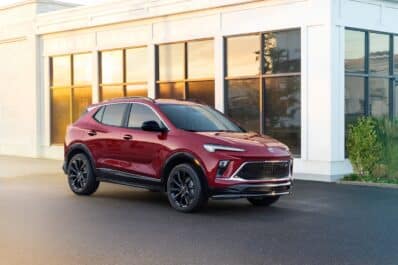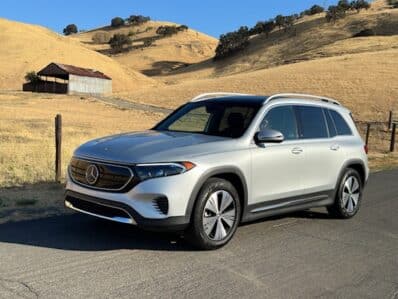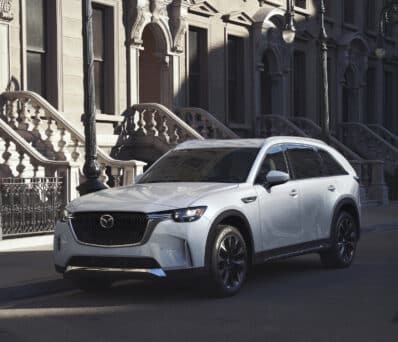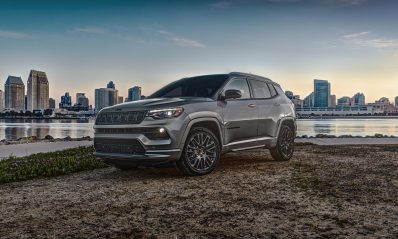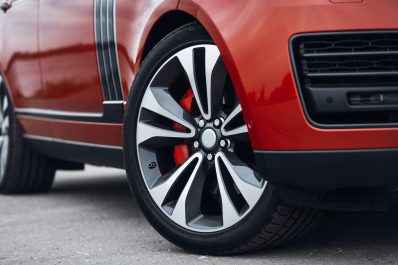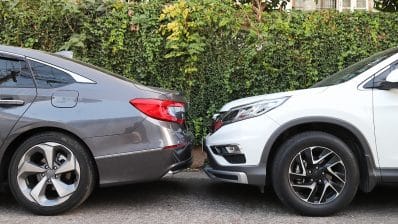When it comes to betting big on batteries, it’s hard to beat Volkswagen. The group, which includes brands as diverse as Spanish-based Seat, Porsche and Bentley, will invest $86 billion in electrification. U.S. motorists already have several offerings, including the VW ID.4 rolling into showrooms late last year.

The original model drew plenty of attention and reasonably solid reviews, among other things winning honors as the World Car of the Year.
With the new model, buyers will get more options, the German automaker rolling out a new, twin-motor version of the ID.4. It not only delivers an extra 100 horsepower but adds all-wheel drive. That’s something I had the chance to check out during a long drive through the mountains outside Chattanooga, Tennessee, where Volkswagen’s U.S. assembly plant is based, and where production of the ID.4 will be added next year.
Overview
The Volkswagen ID.4 is the automaker’s first long-range battery-electric vehicle targeting the U.S. market — though the smaller ID.3 is available in Europe and the ID.6 is being launched in China this year.
All of these products share the same skateboard-style platform, dubbed the MEB. This modular architecture allows for not only a variety of vehicle designs and sizes but also permits different powertrain layouts.
In the case of the ID.4, the original version of the battery-electric vehicle was motivated by a single, rear-mounted motor. With this iteration, VW expands the line-up with the ID.4 AWD which adds a second motor up front and, as the name suggests, gives the small crossover all-wheel-drive capabilities. At a starting price of $43,675 — before factoring in delivery fees and state and local incentives — VW bills the new version as the “most affordable” all-electric vehicle with all-wheel drive now available in the U.S.

Buyers might find it even more financially appealing after factoring in the three years of free charging they get at charging stations run by Electrify America, of which VW is a part owner.
Exterior
As I noted when originally reviewing the ID.4, “green” vehicles tend to go to extremes when it comes to design. Some manufacturers favor the excesses of products like the Toyota Prius. Others don’t want their electrified offerings to look any different at all. With the ID.4, VW struck out for middle ground. It has a distinctively techie and futuristic look — with touches like the light bar running across its nose — but not to excess.
Beyond the light bar on the miniscule grille, along with the unusually short hood, there is little about the ID.4 that would immediately tell someone this is a battery-electric vehicle. There are recessed door handles to reduce wind drag but there are no button door “presenters,” as on the Ford Mustang Mach-E.
The ID.4 is about 4 inches shorter than the conventionally powered Tiguan, though its wheelbase is barely an inch shorter. The cab-forward design takes advantage of the MEB layout. With batteries and motors tucked under the floorboards, space is freed up from what would normally be an engine compartment. This design approach yields a much bigger cabin and cargo area.
Interior

As cautious as Volkswagen designers were with the ID.4 exterior, they really opened up inside, so to speak. This space is decidedly high tech. It’s also surprisingly roomy, especially in the back seat. That’s the benefit of pushing the cabin forward.
There are twin screens, one handling infotainment duties, the other replacing conventional gauges. The reconfigurable display floats over the steering wheel, rather than anchoring to the instrument panel. It actually makes the screen easier to see, however you move your seating position.
The steering wheel has high-tech haptic controls built-in. They’re reasonably easy to use once you figure out whether to tap, slide — or just work with the main infotainment screen atop the center stack.
This is one of the more controversial moves VW made with the ID.4. The infotainment screen gives a motorist a lot of control over the vehicle — including the addition of BEV-unique functions like tracking down charging stations. But it’s not immediately intuitive to operate. Indeed, there are a number of things that are curiously problematic.
Looking to put on the rear defrost or maximum air? Those are about the only traditional buttons in the ID.4 — but they’re tucked away on the left side of the steering wheel. Then there’s the fact there are only two window switches available on the driver’s left armrest. Odd for a four-door. It actually operates all four windows but you have to tap a button to get it to switch from front to rear. It didn’t always work first try. Nor did the infotainment system’s gesture control system always work as expected for things like changing radio stations. And speaking of radio, why did VW leave out the AM spectrum?
Overall, the VW ID.4 cabin has a pleasant look with a hint of Jetsons to it. Seating is comfortable and the flat load floor further improves legroom. But there are clearly some tweaks needed.

Powertrain
The ID.4 initially launched with a single, rear-mounted AC permanent-magnet synchronous motor making 201 horsepower and 228 pound-feet of torque. It draws power from an 82 kilowatt-hour lithium-ion battery pack. Range for this version is 250 miles per charge and it will get you to 60 in under 7.5 seconds.
The new ID.4 AWD model adds a second motor up front, boosting horsepower to 295 and torque to 339. That’s enough to not only cut 0-60 times to 5.4 seconds but also deliver up to 2,700 pounds of towing capacity.
The new package adds “Traction Mode,” which engages both motors to help increase grip on slippery pavement up to speeds of 12 mph. At higher speeds, the ID.4 adds torque vectoring, gently using individual brakes to slow wheels on the inside of the turn to help steer through a tight corner.
At EPA ratings of 249 and 240 miles, respectively, the ID.4 AWD Pro loses a mere 1 mile of range, the more sporty Pro S loses 10 miles compared to the original ID.4
Safety and Technology

The 2022 Volkswagen ID.4 loads up all the cabin technology you’d expect of this type of battery-electric vehicle. The touchscreen is the interior anchor as it operates virtually everything short of those climate buttons to the left of the wheel.
Those comfortable with navigating complex smartphone apps should adapt quickly. The good news is the touchscreen gives you access to an amazing number of ways to adjust vehicle settings. But it can require you to navigate several layers down into sometimes confusing options. Want to turn on the front defrost or start the A/C? There actually are alternate climate control menus, including a standard layout. It can help if the techie alternative could be intimidating.
Unfortunately, the various ways of interfacing with the ID.4 can be challenging. And I found the gesture control system particularly frustrating as it seemed to work almost randomly.
That said, when you figure out how to make all the tech onboard the ID.4 work it’s pretty impressive.
Driving Impressions
As with the original version, one of the odder things to adapt to with the ID.4 is the fact that you don’t actually have to start the SUV manually. It recognizes your key fob and immediately starts. Tap the brake pedal and you’re ready to roll. What would normally be a start button, on the side of the steering wheel, let’s you reduce energy use by putting the vehicle in “accessory mode.”

The unusual, rocking shifter has both standard D, as well as a B mode. The latter increases battery regen when engaged. It’s like driving a gas car with the transmission shifted down a gear or two, but here increasing range. Unfortunately — at least for my taste — there’s not enough regen to really slow you down and allow one-pedal driving. That’s something found on a number of competitors and lets you simply modulate the throttle rather than jumping back and forth between pedals.
In town, one of the real delights of the ID.4 is its turning radius. The AWD model requires a little more room but is still impressive at just 36.4 feet.
As with all the latest BEVs, the skateboard layout offers an unexpected advantage. Though the battery pack is hefty, it actually lowers the ID.4’s center of gravity and gives the SUV a relatively even weight ratio, front to back.
That became particularly apparent as I zoomed around sharp corners during a lengthy drive through the mountains outside Chattanooga. The ID.4 carved smoothly through most of the turns. On a few occasions, where I entered a corner fast, there was a brief sensation of excess understeer. But then, the tires would bite and, I assume, the torque vectoring system kicked in, the ID.4 handily navigating its way through the turn.
My one real complaint is the oddly artificial feel as you first start to turn the steering wheel. For the first couple degrees it feels like you have a huge amount of power assistance. Then the steering gets heavier as you dive into the turn. It’s a minor matter but did take time to get used to.
I’m looking forward to spending time in the ID.4 AWD this winter. Even without all-wheel drive, the rear-engine model proved surprisingly adept at handling slippery roads.
2021 Volkswagen ID.4 AWD Pro S specifications:
| Dimension | L: 180.5 inches/W: 72.9 inches/H: 65.1 inches/Wheelbase: 108.7 inches |
| Weight | 4,888 pounds |
| Powertrain | two ASM asynchronous electric motors |
| Fuel Economy | 98 mpg-e city/88 mpg-e highway/93 mpg-e combined |
| Performance Specs | 295 horsepower and 339 pound-feet of torque |
| Price | Base price: $48,175, plus $1,195 destination and delivery charge |
| On-Sale Date | Available now |
Wrap Up
The coming year is going to be a significant one when it comes to the auto industry’s migration to battery power. As I noted in a two-part feature on TheDetroitBureau.com earlier this week, at least 39 completely new battery-electric vehicles will come to market by late 2022. That means a lot more competition for the ID.4, which already faces off with tough competitors like the Tesla Model Y, Chevrolet Bolt EUV and Tesla Model Y.
The Volkswagen crossover has done reasonably well, and a starting price of around $40,000 for the base, single-motor model has certainly helped. For 2022, the VW ID.4 AWD Pro will start at $43,675 — before adding $1,195 in delivery fees and discounting the $7,500 in federal tax credits. To that, VW officials point out, you also could factor in around $4,000 in energy cost savings if you regularly charge at an Electrify America station.
The Pro S model jumps to a starting price of $48,175. And you can add a black roof, silver accents and 20-inch wheels and tires with the $1,500 Gradient Package.
Along with the obvious BEV competitors, VW is targeting some conventional, gas-powered options, such as the Toyota RAV4 XLE and Honda CR-V Hybrid EX. They both start around $30,000, but the price gap narrows when you calculate in the federal tax credits and energy savings.
After now spending time in all the various Volkswagen ID.4 models I am, for the most part, impressed with what the German automaker has come up with. The electric SUV is fun to drive, and the AWD package enhances the experience, both in terms of winter traction and warm weather handling. Yes, there are a handful of niggling annoyances, notably the window switches. But, by a wide margin, the ID.4 overcomes its weaknesses and provides a good reason for many buyers to go electric.
2021 Volkswagen ID.4 AWD Pro S — Frequently Asked Questions
Is the ID.4 any good?
The Volkswagen ID.4 has a lot going for it, and the addition of all-wheel-drive significantly enhances the overall package. There are a few, small gripes, and we’ve love to have longer range, but the overall vote is a strong thumbs up.
How much will the ID.4 cost?
The base, single-motor package starts around $40,000. The new AWD version starts at $43,675. But you need to factor in $7,500 in federal tax credits – and, possibly, state incentives, depending upon where you live. You could also save as much as $4,000 over three years due to free charging at Electrify America stations, VW estimates.
What does the “ID” stand for?
While there may some additional meanings in German, those letters translate into “Intelligent Design,” here in the U.S. It’s also the name Volkswagen is using for an entire sub-brand of battery-electric vehicles going forward.





